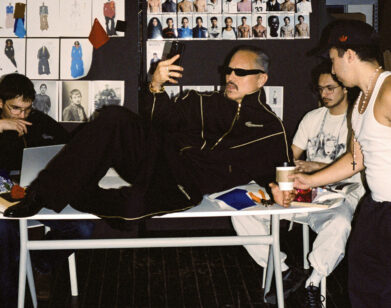Re-Introducing: Esteban Cortazar

HANNE GABY AND ESTEBAN CORTAZAR FOR THE EXITO LOOKBOOK
PHOTOS BY TIGRE ESCOBAR. STYLING BY JAIME RUBIANO
MEDELLIN, COLOMBIA: Esteban Cortazar is back. The Bogotá-born designer hit headlines in 2007 when he was made creative director at Emanuel Ungaro, at the age of just 23—and again in 2009 for walking out, after being asked to collaborate with the house’s new creative consultant, Lindsay Lohan.
A year later, he is focusing on Colombian women. On Tuesday, his brand new collaboration with retailer Exito hit stores all over the country—like Zac Posen for Target or Karl Lagerfeld for H&M, the collection offers sophisticated, designed apparel, mass produced and relatively cheap. In a country with a nascent sense of fashion, Cortazar is introducing platform heels, leopard print and shoulder pads. He met with us during Colombian Fashion Week, held in Medellin and concluding today.
ALICE PFEIFFER: May we ask what happened during the much-talked-out Lindsay Lohan power struggle at Ungaro? When and how did you realize it was time to leave?
ESTEBAN CORTAZAR: When I moved to Paris, I got so much respect for the city’s creativity, craftsmanship, and history. Ungaro too has an incredible legacy, and I wanted my designs to be inspired by the house’s past, and infuse it in today’s girl. The arrival of Lindsay Lohan felt like a strategy to generate press, not a genuine, organic choice. It was imposed on me and just didn’t feel right. It became a constant discussion for months, and we finally decided the best decision was to part ways.
CAMPANA
PFEIFFER: Today, you have just launched a collection sold all over Colombia. Why did this project appeal to you after your experience in Paris-based ready-to-wear?
CORTAZAR: It appealed to me because I wanted to do something in Colombia for a very long time but never had the chance. It is not a country that is exposed to worldwide fashion, and there are very few options to shop. Today, there is a democratization happening in fashion all over the world—and that especially makes sense for Colombia, where there is such a gap between the people who can afford to buy luxury and the people who cannot. I’m not leaving haute couture, but this project allows me to share the experience I’ve gained abroad, and give back to the people here who have shown me so much support from the beginning.
PFEIFFER: Why were you interested in dressing Colombian women? How do they differ from French women?
CORTAZAR: Women here are the epitome of what a Latin woman represents: flamboyant, sexy, feminine, curvaceous; French women have a totally different body type and culture, and are more exposed to fashion. The idea was to mix those two worlds and bring an aesthetic that might be intimidating for women here to explore. The only way for it to work was for it to be made by a Colombian designer, because they feel they can relate to it.
PFEIFFER: How is this mix reflected in the collection?
CORTAZAR: Starting with the fabric selection, I worked with national Colombian fabrics, but also Italian, Japanese fabrics. The idea was to mix the industries, bring people I have access to in Paris and get them involved – for example, the studio director at Balmain worked on the project. Also, the models were a mix of girls from Ford, Hanne Gaby who is the face of the campaign, and local models. As for the clothes, I tried to create a balance between sexy and disheveled elements.
PFEIFFER: You were just given the Colombiano de Corazón (Colombian at Heart) award for bringing a more positive image to the country. How does it feel? Is helping out Colombia a long-term project for you?
CORTAZAR: I felt very honored, very moved to get this award. Colombia is a country that has gone through so many problems and it makes people proud when something positive comes out. And for any Colombian who makes it in the States or Europe, it almost feels like a natural compromise to make people look at the country in a new way.






